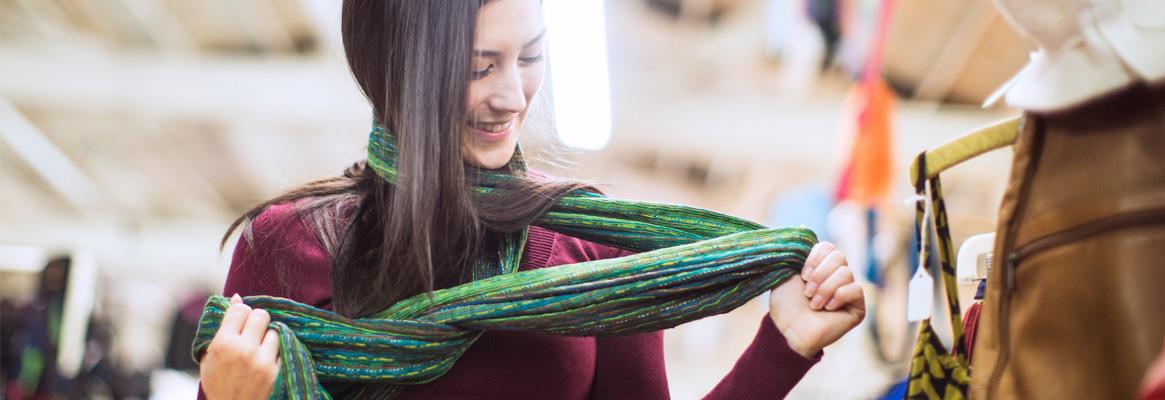The scarf is one among the few bisexual fashion accessories that can be used both in summer and winter. From the olden days when scarves indicated the social status of a person to an era where sites are flooded with knotting styles of this accessory as a fashion element, photoshoots these days are incomplete without the shot of a model with a scarf on, writes S Aishwariya.
The scarf is a timeless fashion accessory. Its recorded history dates to ancient Rome, where a square cloth called the "sudarium" was used by the working classes. This cloth was a precursor to the modern-day scarf. It would be used as a handkerchief, a belt or even a tie. The scarf as a fashion accessory was first noticed when Egyptian princess Neferiti during her reign circa 1300 BC would wear a conical head dress complimented by a neatly draped scarf on the neck, exhibiting her style.
Archaeological evidence points to the fact that the Chinese too had a deep-rooted tradition of using scarves as a sign of ranking in the military. Statues from 1000 BC unveil the use of different scarves for each element of ranking among soldiers. Similar to uniform accents and hair styles, these scarves were just as significant in indicating the cadre, position and power given to a particular person.
Times went by before German composer Ludwig van Beethoven started wearing silk scarves to compliment his suit-both as a makeover and to win the heart of lady-love Teresa. This style showed the role of the scarf in grooming and expressing self-confidence, professionalism and attraction.
Those days, quality scarves were traded as a means of cultural exchange and also as a souvenir from travels. It is said that Josephine, Napoleon's mistress was gifted Pashmina scarves from India as a sign of love and a gift of excellent craftmanship made with the finest quality yarns and designs. By the end of the seventeenth century, knitted scarves became popular in the market.
Cravats: The fashionable scarf
In the 17th century, cravats-the precursor to today's neck-tie-were quite popular. The colour was usually based on the political status of a person. This 'classic' remains a forever-trend in the look-book of men's designer clothing. In this era, it was also a ritual to offer scarves to people at funerals.
At the end of the 18th century, Parisian designer Hermes created a fresh look in silk scarves with graphical printing techniques. Around the same time, Queen Victoria would be seen wearing scarves on public occasions; this made the scarf even more popular, particularly among women who were seen more in public spaces than earlier. It would soon become essential to maintain a formal look that was perceived to be neat and sophisticated, for which scarves had an important role to play.
The 19th century began with countries like the United States making knitting a mandatory job for the people. Hence, knitted scarves gained more traction. The trend from silk knits ended up with fur scarves that were suitable for most Western countries in combating cold. The style of wearing a scarf as a single piece garment created a chic and sassy look.
The scarf in the 20th century
Scarves are today used for warmth as well as protection from the sun and keeping away dust, as a statement of fashion, as also for religious reasons/occasions. The scarf is both a necessity and an accessory, and is available in shapes of squares, rectangles and even circles.
These are primarily made of cotton, wool, silk and linen. In cutting down costs, rayon, nylon and other synthetic fabrics are fast gaining popularity in the mass market. Top international brands like Alexander McQueen, Cole Haan, Coco Chanel, Lanvin, Hermes, Nicole Miller, Ferragamo, Emilio Pucci, Christian Dior, Fendi, Louis Vuitton and Prada all have separate lines of design, production and sales for scarves. China is the leading manufacturer followed by India, Hong Kong and Indonesia.
Usage remains varied. For instance, air force pilots use a functional notch on a scarf. During flights in the early days, air force pilots would invariably need to turn their heads to check for enemy planes coming in from the rear. So, in order to protect their necks from possible sprains, they would use scarves. Those were usually made of silk, and the patterns would indicate the respective squadrons.
Elsewhere, In the academic fraternity, scarves are used to indicate identity and belonging. In schools, scouts and guides wear distinctive colours and have styles of draping them to show the connectivity of a cadet to a particular school. Universities in the UK issue scarves as part of the uniform and insist on those being worn on important days and during graduation ceremonies.
Many religions prescribe covering the head when in front of people of higher ranking and at religious places. It is also an accessory that represents the belief of a person. This can be seen among both Christians and Muslims. In Arab countries, people wear scarves to cover the head and chest. Shayla, hijab, al-amira, khimar, chador, niquab and burka are some of the styles of wearing a scarf.
Formal and Versatile
A scarf can compliment formal wear. It can be a receptionist, an air hostess, a waitress, an army officer, a pilot or a sailor who wears that scarf. In Egypt, belly dancers used embellished scarves around the waist to accentuate their moves. In cold countries, people layer their garments, and scarves are used around the neck for both functional and fashion purposes.
Mufflers and neck-wraps are other commonly used names for scarves. The texture and construction of knitted scarves play a vital role in trapping the body heat and keeping the blood warm. Various shapes styles and infinite loop (circular scarf) are definitive pieces ideal for winterwear.
In summers, scarves are worn on a tube top or sleeveless gown to create an ethnic look. In warmer places like India, bandanas are common. There are various ways of wearing bandanas, which are styled to keep the hair protected from excessive heat and sweat. Bandhini and other traditional dyeing, printing, embroideries are commonly seen on the scarves as value additions.
In order to hold the scarf in place and add another accessory, scarf rings are used. These are usually made of silver, gold, mother of pearl and horn. Metal pieces with moulds and motifs are also used to create fashion statements. Belts can be used when garments are layered with the aid of a scarf.
The author is INSPIRE Fellow (DST-GOI) and Assistant Professor, Department of Textiles and Clothing, Avinashilingam University for Women, Coimbatore, Tamil Nadu.









Comments